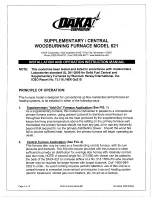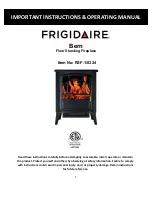
23
Cleaning Ts simplify the cleaning of the chimney.
Seal all connections of the chimney connector with heat resistant putty.
If there are drilled orifices in the connection collar of the appliance, secure the
chimney connector to the stove collar, using the appropriate screws. This ensures
the adjustment and prevents vibrations which could lead to a separation of the
connections.
Caps
There is a wide variety of caps for chimneys.
It is important for the cap to be well secured and for the separation between the chimney is
at least the same as its diameter.
Flue shut-off valve
In general, it is not necessary to use a flue shut-off valve in a correct installation.
Some installations, however, may benefit from a flue shut-off valve, such as high
chimneys which may create stronger flues than normal.
In any case, a flue shut-off valve may help to regulate the flue. A solid fuel appliance
requires a flue of between 1.5 and 2.5 mm.c.a. (See manufacturer’s characteristics) (See
the chapter on Technical Data).
If the chimney flue is greater, it is advisable to install a flue shut-off valve.
Flue shut-off valves should never fully close the smoke passage. A minimum space of 20
% should always remain free.
Linings, protectors...
Respect th
e manufacturer’s recommended clearances to combustible surfaces of the
stove and the chimney pipe.
If this is not possible, protect these materials with the appropriate protectors.
There are special protectors to install on combustible walls when the chimney connector
passes close by or through them. The aim is to protect the wall against fire.
A wall protector should be installed when a chimney connector is installed through a
combustible wall or close by and is susceptible to damage.
The wall pass-through protects the wall internally from combustion. This part should be
used when the chimney is connected through walls or ceilings.
Chimney Pipe
Chimneys for solid fuel appliances should be masonry built or prefabricated with materials
which withstand high temperatures.
Therefore, if you are going to build a chimney for your stove, there are two alternatives:
Masonry Chimneys.
Metal Chimneys
There is not much difference in terms of performance and operation between metal and
masonry chimneys.
Whenever possible, locate your chimney inside the house, hence obtaining a better flue, less
creosote build-up and a longer duration.
Do not install your stove without checking that the chimney is valid for use.
Prior to installing the appliance, examine the chimney for cracks, poor connections,
oxidation, loose mortar or other signs of deterioration and blockage.
Make sure the size of the chimney is appropriate for the stove. Consult the manufacturer’s
recommended dimensions.
Summary of Contents for E-10 PLUS
Page 2: ...2...
Page 19: ...19 Se recomienda usar piezas de repuesto recomendadas por el fabricante 7 DIMENSIONES Fig 15...
Page 37: ...37 7 DIMENSIONS...
Page 55: ...55 7 DIMENSIONS...
Page 73: ...73 Recomenda se usar pe as de substitui o recomendadas pelo fabricante 7 DIMENS ES...
Page 91: ...91 7 DIMENSIONI...
Page 93: ...93...
Page 94: ...94...
Page 95: ...95...
Page 96: ...96...
Page 97: ...97...
Page 98: ...98...
Page 99: ...99...
















































